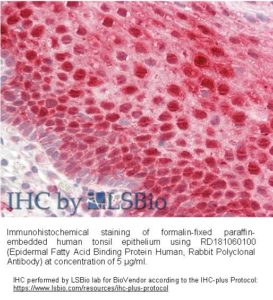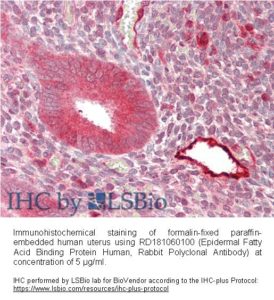Epidermal Fatty Acid Binding Protein Human, Rabbit Polyclonal Antibody
Human fatty acid binding protein EFABP is a 15 kD member of the intracellular fatty acid binding protein (FABP) family, which is known for the ability to bind fatty acids and related compounds ( bile acids or retinoids). in an internal cavity. The fatty acid binding proteins aP2 (fatty acid binding protein [FABP]-4) and mal1 (EFABP) are closely related and both are expressed in adipocytes. Absence of EFABP/mal1 resulted in increased systemic insulin sensitivity in two models of obesity and insulin resistance. Adipocytes isolated from mal1-deficient mice also exhibited enhanced insulin-stimulated glucose transport capacity. In contrast, mice expressing high levels of mal1 in adipose tissue display reduced systemic insulin sensitivity .
Type
Polyclonal Antibody
Applications
Western blotting, ELISA, Immunohistochemistry
Antibodies Applications


Source of Antigen
E. coli
Hosts
Rabbit
Preparation
The antibody was raised in rabbits by immunization with the recombinant Human FABP5.
Amino Acid Sequence
The immunization antigen (15.2 kDa) is a protein containing 135 AA of recombinant Human FABP5 and one extra AA, N-terminal methionin (highlighted).
Species Reactivity
Human. Not yet tested in other species.
Purification Method
Immunoaffinity chromatography on a column with immobilized recombinant Human FABP5.
Antibody Content
0.1 mg (determined by BCA method, BSA was used as a standard)
Formulation
The antibody is lyophilized in 0.05 M phosphate buffer, 0.1 M NaCl, pH 7.2. AZIDE FREE.
Reconstitution
Add 0.2 ml of deionized water and let the lyophilized pellet dissolve completely. Slight turbidity may occur after reconstitution, which does not affect activity of the antibody. In this case clarify the solution by centrifugation.
Shipping
At ambient temperature. Upon receipt, store the product at the temperature recommended below.
Storage/Expiration
The lyophilized antibody remains stable and fully active until the expiry date when stored at –20°C. Aliquot the product after reconstitution to avoid repeated freezing/thawing cycles and store frozen at –80°C. Reconstituted antibody can be stored at 4°C for a limited period of time; it does not show decline in activity after one week at 4°C.
Quality Control Test
Indirect ELISA – to determine titer of the antibody
SDS PAGE – to determine purity of the antibody
Note
This product is for research use only.
– Martin GG, Chung S, Landrock D, Landrock KK, Dangott LJ, Peng X, Kaczocha M, Murphy EJ, Kier AB, Schroeder F. Female Mice are Resistant to Fabp1 Gene Ablation-Induced Alterations in Brain Endocannabinoid Levels. Lipids. 2016 Jul 23;
– Martin GG, Chung S, Landrock D, Landrock KK, Huang H, Dangott LJ, Peng X, Kaczocha M, Seeger DR, Murphy EJ, Golovko MY, Kier AB, Schroeder F. Fabp-1 gene ablation impacts brain endocannabinoid system in male mice. J Neurochem. 2016 May 11;
– Peng X, Studholme K, Kanjiya MP, Luk J, Bogdan D, Elmes MW, Carbonetti G, Tong S, Gary Teng YH, Rizzo RC, Li H, Deutsch DG, Ojima I, Rebecchi MJ, Puopolo M, Kaczocha M. Fatty-acid-binding protein inhibition produces analgesic effects through peripheral and central mechanisms. Mol Pain. 2017 Jan;13:1744806917697007. doi: 10.1177/1744806917697007
– Yamane Y, Moriyama K, Yasuda C, Miyata S, Aihara M, Ikezawa Z, Miyazaki K. New horny layer marker proteins for evaluating skin condition in atopic dermatitis. Int Arch Allergy Immunol. 2009;150 (1):89-101

